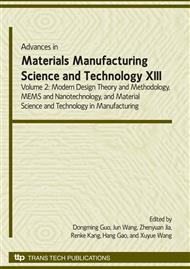p.43
p.49
p.55
p.61
p.67
p.73
p.77
p.83
p.89
Optimization Design of a Vibrating System with Two Motors
Abstract:
The dynamic model of vibrating system with two motors is established. Through dynamic analysis, the equations of frequency capture of the vibrating system and the conditions of implementing stable self-synchronous operation are obtained. Then the vibrating system is optimization designed based on the conditions of implementing stable self-synchronous operation. The simulation program with proper parameters of vibrating system is run, and the results show that the system is in a good synchronous state. Computer simulations demonstrate that the vibrating system realizes speed synchronization and phase synchronization. The results verify the effectiveness of the optimization design.
Info:
Periodical:
Pages:
67-72
Citation:
Online since:
August 2009
Authors:
Price:
Сopyright:
© 2009 Trans Tech Publications Ltd. All Rights Reserved
Share:
Citation:


